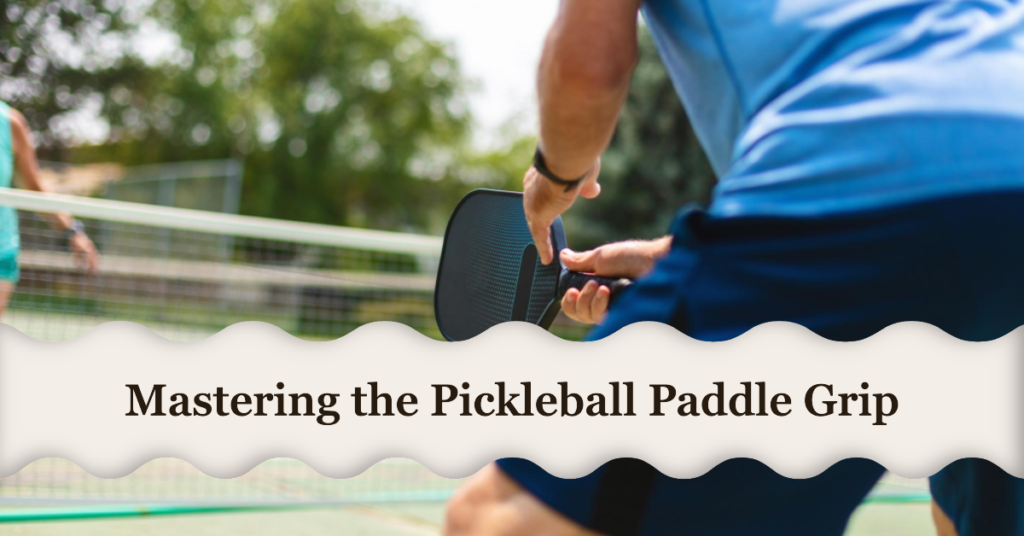Picture this: You’re on the pickleball court, ready to take that winning shot, the rally hanging in the balance. You’ve honed your skills and strategized your moves, but one crucial element that often goes overlooked is your pickleball paddle grip. Surprised? Don’t be. Holding a pickleball paddle correctly can be the game-changer you’ve been seeking, elevating your performance from average to exceptional.
The problem is that many pickleball enthusiasts underestimate the importance of this fundamental skill, unknowingly sabotaging their own game. Are you struggling with control, power, or accuracy? Are your shots falling short, or worse, out of bounds? Fret not, for you’ve landed on the solution – our comprehensive guide on how to hold a pickleball paddle.
In this article, we’ll unlock the secrets to the perfect pickleball paddle grip, explaining why it matters, addressing common pitfalls, and providing expert tips to help you dominate the court. Whether you’re a beginner seeking a solid foundation or an experienced player looking to refine your skills, read on to discover the key to pickleball success.
How To Hold a Pickleball Paddle? All You Need to Know
To hold a pickleball paddle, grip it firmly using your dominant hand with your fingers wrapped around the handle. Keep your fingers relaxed and ensure a comfortable grip. Wrap your fingers around the handle, creating a secure connection between your hand and the paddle. Maintaining an open hand is essential, avoiding any tension in your fingers, as this can lead to discomfort and decreased control.
However, to master this art. We have to dig a bit deeper. Because, Pickleball is a racket sport that combines elements of tennis, badminton, and ping pong. So, before we know how to hold the pickleball paddle correctly, it is essential to start with the basics.
Understanding The Anatomy Of A Pickleball Paddle Grip
The anatomy of a pickleball paddle grip is essential to mastering how to hold the paddle correctly. By understanding the grip’s structure and technique, players can improve their control and performance on the court.
When it comes to playing Pickleball, understanding the anatomy of your paddle grip is essential for optimal performance and control on the court. A proper grip gives you a firm hold on the paddle and enables you to execute shots precisely and accurately.
This section will delve into the different components of a pickleball paddle grip and highlight the importance of using the correct grip for your game.
a. Different Components Of A Pickleball Paddle Grip
A pickleball paddle grip consists of various elements that work together to provide control and stability during gameplay. Understanding these different components will help you achieve the best grip possible:
- Handle: The handle is the part of the paddle that you hold during play. It usually has a cushioned grip, providing comfort and reducing the risk of slippage.
- Overgrip: An overgrip is a thin layer of additional grip material that can be wrapped around the handle to enhance traction. It can cushion and absorb sweat, ensuring a secure grip even during intense rallies.
- Weight and Balance: The weight and balance of a paddle can affect your grip and overall performance. Lighter paddles are more accessible to maneuver and offer more control, while heavier ones can provide additional power. Finding the right weight and balance for your playing style is crucial.
- Grip Size: Pickleball paddles come in different grip sizes to accommodate various hand sizes. Choosing the right grip size ensures proper hand fit, essential for maintaining control and preventing discomfort or injury.
- Grip Shape: Paddle grips come in different shapes, such as cylindrical, square, or contoured. Each profile offers a unique feel in hand, so it’s essential to experiment and find the one that suits your preference and playstyle.
b. Importance Of A Proper Grip For Performance And Control
A proper grip is fundamental for maximizing your performance and controlling your shots. Here are a few reasons why having the correct grip is vital:
- Shot Execution: A proper grip allows you to generate the right amount of power and spin on your shots, improving shot accuracy and consistency.
- Control and Stability: With a secure grip, you can maintain control over the paddle, even during fast-paced rallies. It enables you to react quickly and make adjustments when needed.
- Injury Prevention: Using the correct grip reduces the risk of developing hand and wrist injuries. It ensures that your hand is aligned correctly and prevents excessive strain on muscles and tendons.
- Comfort and Endurance: Holding the paddle with the proper grip reduces discomfort and fatigue during prolonged play sessions. It allows you to focus on the game without distraction.
- Overall Performance: A proper grip contributes to your overall playing experience by enhancing your confidence and enabling you to utilize the paddle’s potential fully.
Now that you have a better understanding of the anatomy of a pickleball paddle grip and the importance of using the correct grip, you can apply this knowledge to improve your gameplay. Experiment with different grip sizes, shapes, and additional grip materials to find the combination that suits you best.
Popular Grip Techniques Used In Pickleball
Discover the most popular grip techniques used in Pickleball for holding your paddle. Learn the best ways to grip your pickleball paddle for better control and accuracy on the court.
a. Eastern Grip And Its Benefits:
- The Eastern grip is one of the most popular techniques used in Pickleball, offering several benefits for players.
- It involves placing the index knuckle on the paddle’s bottom angle, with the other fingers comfortably positioned on the handle.
- Benefits of the Eastern grip include improved control and accuracy, allowing players to maneuver the paddle during shots easily.
- This grip also enables quick and seamless transitions between different shots, ensuring better consistency in gameplay.
b. Western Grip And How It Enhances Spin:
- The Western grip is another widely used technique in Pickleball, particularly favored by players who prioritize generating spin on their shots.
- With the Western grip, the index knuckle is positioned on the face of the paddle while other fingers clasp the handle.
- This grip facilitates a more remarkable ability to put spin on the ball, thereby adding an element of unpredictability to shots.
- Players utilizing the Western grip can produce topspin or sidespin, creating deceptive shots that catch opponents off guard.
c. Continental Grip And Its Versatility:
- The Continental grip is known for its versatility, making it a popular choice among pickleball players, especially those who prefer to switch between different shots seamlessly.
- In this grip, the index knuckle is placed on the top angle of the paddle, allowing for a neutral stance during shots.
- The Continental grip is suited for players who like to mix up their shots, enabling easy transitions between forehand and backhand strokes.
- With this grip, players can execute a variety of shots, including volleys, smashes, blocks, and dinks, ensuring adaptability during gameplay.
Remember, mastering these grip techniques is essential for enhancing your pickleball skills and overall performance on the court.
Mastering The Eastern Grip: Step-By-Step Guide
Learn how to master the Eastern grip with this step-by-step guide, which shows you how to hold a pickleball paddle effectively. Discover the correct technique to improve your game and enhance your paddle control.
Mastering the proper grip for your pickleball paddle is crucial in achieving optimal control and power during games. The Eastern grip is a popular choice among players, allowing for versatility in shot selection. This guide will walk you through mastering the Eastern grip, from identifying the correct placement to adjusting it to suit your playing style.
a. Identifying The Correct Grip Placement:
To start, it’s essential to understand where precisely your hand should be placed on the paddle handle for the Eastern grip. Follow these steps to ensure you have the correct grip placement:
- Hold the paddle with your non-dominant hand, ensuring measuring the paddle face is parallel to the ground.
- Place your dominant hand on the handle, slightly below the center point.
- Wrap your fingers around the handle, ensuring a firm and comfortable grip.
- The base knuckle of your index finger should be positioned on the bottom angle of the handle.
b. Proper Hand Positioning For Optimal Control And Power:
Once you have identified the correct grip placement, it’s time to focus on your hand positioning. Follow these guidelines to achieve optimal control and power:
- Your wrist should be relaxed and neutral, allowing fluid movement during swings.
- The heel of your palm should rest against the grip, providing stability and control.
- Maintain a loose grip, avoiding excessive tension in your fingers and forearm.
- Keep your thumb slightly bent and resting against the side of the handle, providing additional support.
c. Tips For Adjusting The Grip To Suit Your Playing Style:
Every player is unique, and adjusting the grip to suit your playing style and preferences is essential. Consider these tips for finding your ideal grip:
- Experiment with different finger placements to find the most comfortable and practical grip for your shots.
- Adjust your grip slightly higher on the handle if you tend to hit with more topspin.
- For increased power, you can consider sliding your hand down the handle for a lower grip placement.
- Pay attention to your shots’ feelings and make subtle adjustments to find your optimal grip position.
Mastering the Eastern grip is a fundamental step towards improving your pickleball game. By identifying the correct grip placement, maintaining proper hand positioning, and adjusting the grip to suit your playing style, you’ll be well on your way to gaining better control and power on the court.
Enhancing Spin With The Western Grip: Dos And Don’Ts
Learn to hold a pickleball paddle with the Western grip for enhanced spin. Discover the dos and don’ts to optimize your technique and add more spin to your shots.
a. Understanding The Unique Hand Position Of The Western Grip
The Western grip is a technique pickleball players use to enhance spin on their shots. Unlike other grips, the Western grip involves placing the index finger’s base knuckle on the paddle handle’s first bevel, creating a more extreme angle.
This hand position allows for greater control and power in generating spin. Here’s what you need to know about the unique hand position of the Western grip:
- The index finger’s base knuckle should rest on the first angle of the paddle handle.
- The knuckles of the other fingers should be diagonal to the handle, forming a V shape with the index finger.
- The grip should feel firm but not overly tight, allowing for flexibility in movement.
b. Techniques To Generate Spin With The Western Grip
Now that you understand the hand position of the Western grip let’s explore some techniques to generate spin with this grip. Mastering these techniques will help you add more spin to your shots and keep your opponents on their toes.
Here are the techniques you can use:
- Brushing the ball: To enhance spin, focus on touching the ball with your paddle strings. Imagine trying to create a brushing motion rather than a straight hit.
- Racket head speed: Increase the speed of your racket head to generate more spin. The faster the racket head moves through the contact point, the greater the spin produced.
- The angle of the paddle face: Experiment with the tip of your face to turn the sweet spot for maximum spin. Slight adjustments can significantly affect the amount and trajectory of the reel.
c. Common Mistakes To AvreelWhen Using This Grip
While the Western grip has its advantages in generating spin, it’s essential to be aware of common mistakes to avoid. Removing these pitfalls can ensure better control and effectiveness with your shots. Here are some common mistakes to watch out for:
- Gripping too tightly: Holding the paddle too tightly can restrict your movement and reduce the spin potential. Maintain a firm but relaxed grip for greater flexibility and wrist action.
- Incorrect hand position: Ensure your index finger’s base knuckle rests on the first angle of the paddle handle. Any deviation can affect the desired spin and control.
- Over-reliance on spin: While spin can add deception and control to your shots, relying solely on spin can make your photos predictable. Mix your images with different techniques and strategies to keep your opponents guessing.
Remember, mastering the Western grip takes practice and experimentation. By understanding the hand position, utilizing spin techniques, and avoiding common mistakes, you’ll improve your spin game in Pickleball.
Exploring The Versatility Of The Continental Grip
Discover the versatility of the Continental Grip as you master how to hold your pickleball paddle. Unlock its adaptability and enhance your gameplay with this essential technique.
Picture yourself in a fast-paced game of Pickleball, strategizing your next move to outsmart your opponent. Proper grip technique can make the difference between distinguishing a missed opportunity. One grip that can enhance your performance across different playing situations is the Continental grip.
Let’s dive into the benefits of this grip, learn how to adapt it for various shots and strategies, and discover tips for transitioning between grips during gameplay.
a. Benefits Of The Continental Grip In Different Playing Situations:
- Greater control: The Continental grip allows precise control over the paddle, allowing you to place your shots accurately
- Increased power: Using the Continental grip, you can generate more power behind your hits, especially for overhead shots and serves.
- Spin potential: With this grip, you can easily add spin to the ball, allowing for better shot placement and added complexity for your opponents.
b. Adapting The Continental Grip For Different Shots And Strategies:
- Groundstrokes: For forehand and backhand groundstrokes, slightly modify the Continental grip by placing it more on the handle. This adjustment provides stability and control for consistent shots.
- VVolleyshots To master volley shots, use the standard Continental grip. It offers excellent maneuverability and responsiveness for quick reactions at the net.
- Overhead shots: When executing overhead smashes or lobs, use the Continental grip with a slight variation. Place your thumb slightly on the flat face of the paddle for better control and power.
c. Tips For Transitioning Between Different Grips During Gameplay:
- Practice and muscle memory: Mastering grip transitions requires an approach. Initially, it may feel unnatural, but muscle memory will help you seamlessly switch between grips during gameplay with a consistent approach.
- Pre-shot routine: Develop a pre-shot practice that incorporates grip adjustments. Whether it’s a brief moment between points or during your opponent’s shot, consciously adjust your grip smoothly before hitting the ball.
- Experiment with grip pressure: You adapt to different shots and playing situations by adjusting the force applied to the triforce. Experiment with grip pressure to find the balance between control and comfort.
Embrace the versatility of the Continental grip and unleash your full potential on the pickleball court. You’ll gain a competitive edge in your gameplay by understanding its benefits, adapting it for various shots and strategies, and employing smooth transitions between grips,
So grab your paddle,holdsriment with the Continental grip, and elevate your pickleball skills to new heights!
Grip Maintenance And Precautions
Maintaining a proper grip on your pickleball paddle is crucial for optimal performance. Follow these guidelines to ensure a secure hold, enhancing your gameplay and reducing the risk of injury.
Maintaining the grip of your pickleball paddle is crucial for its longevity and your overall performance on the court. By regularly maintaining your grip, cleaning and storing your paddle correctly, and taking precautions to prevent grip-related injuries, you can ensure a better playing experience.
This section will discuss tips and techniques to help you keep your pickleball paddle grip in optimal condition.
a. Regular Maintenance To Prolong The Life Of Your Grip:
- Inspect your grip: Regularly examine your pickleball paddle grip for signs of wear and tear, such as fraying or thinning of the material. It might be time to replace your grip. If you notice any significant damage
- Rotate your grip: To avoid uneven wear, periodically rotate your grip on the paddle. This can help distribute pressure more evenly and prolong the lifespan of your grasp.
- Clean your grip: Keep it clean by wiping it down with a damp cloth or using mild soap and water. Avoid using harsh chemicals that could damage the grip material.
- Avoid excessive moisture: Excessive moisture can degrade the grip material over time. After playing in wet or sweaty conditions, thoroughly dry your grip before storing it.
b. How To Clean And Store Your Pickleball Paddle:
- Clean with mild soap and water: To clean your pickleball paddle, use a mild soap and water solution. Scrub the paddle’s face and grip it with a soft cloth or sponge. Rinse thoroughly and allow it to air dry.
- Avoid submerging the paddle: Avoid submerging it in water to its core and other components. Instead, focus on cleaning the grip and face of the paddle.
- Store in a cool, dry place: When not in use, store your pickleball paddle in a cool, dry place. Avoid leaving it in direct sunlight or extreme temperatures, as these conditions can warp or damage the paddle.
- Protect the grip during storage: To prevent the grip from sticking to other surfaces or collecting dust, consider using a paddle cover or wrapping the hold with a cloth or towel.
c. Preventing Common Grip-Related Injuries And Discomfort:
- Choose the right grip size: A properly fitting grip can significantly reduce the risk of injuries and discomfort. Select a paddle with the appropriate grip size for your hand.
- Maintain a relaxed grip: Practice maintaining a comfortable grip on the paddle to comfort your hand and forearm muscles. Avoid gripping the paddle too tightly, leading to fatigue and potential injuries.
- Take breaks and stretch: Avoid excessive and prolonged use of the paddle, as it can strain your grip. Take regular intervals during play and perform simple stretching exercises to relieve tension in your hands and forearms.
- Consider grip enhancements: If you experience recurring discomfort or find it challenging to maintain a secure grip, explore grip enhancements such as overgrips or replacement grips. These can provide additional cushioning and improve grip stability.
By following these grip maintenance and preventive measures, you can extend the life of your pickleball paddle grip, ensure optimal performance, and reduce the risk of grip-related injuries. Remember, a well-maintained and comfortable grip can make your overall pickleball playing experience.
Choosing The Right Grip For Your Playing Style
Choosing the proper grip for your playing style is essential to excel in Pickleball. Learn how to hold the paddle correctly to enhance your performance on the court.
Analyzing your playing style and grip preferences:
- Understanding your playing style is crucial in choosing the proper grip for your pickleball paddle.
- Whether you prefer a more aggressive or defensive approach, your grip can significantly impact your overall performance.
- Consider facConsiderize, strength, and level of comfort when holding the paddle.
Factors to consider when selecting a grip:
- Hand size: Larger hands may require a thicker grip to ensure a secure hold, while smaller hands may benefit from a slimmer grip for better control.
- Playing style: Aggressive players may prefer a firm grip that allows for a mighty swing, while defending stylers may opt for a softer grip that provides better touch and finesse.
- Paddle material: Grips come in various materials, such as cushioned, perforated, or tacky. Consider the material that suits your playing style and ensures a comfortable grip during long matches.
- Sweat absorption: Some grips are designed to absorb moisture and maintain a dry surface, preventing any discomfort caused by sweaty hands.
Recommendations for different playing styles:
- Aggressive players: If you enjoy a power-based playing style and look to dominate the game with solid shots and smashes, consider the following grip options:
- Thick cushioned grip: Provides extra comfort and minimizes hand fatigue during intense gameplay.
- Tacky grip: Offers a secure hold and enhances control, allowing for more accurate shots.
- Defensive players: If you prefer a defensive playing style that focuses on agility, placement, and control, the following grip options may suit you best:
- Slim grip: Allows for better maneuverability and agility on the court, enhancing your ability to place the ball precisely.
- Perforated grip: Promotes breathability and sweat absorption, ensuring a dry and comfortable grip even during longer matches.
- All-around players: If you have a versatile playing style and like to switch between offense and defense, the following grip options offer a balanced approach:
- Medium thickness grip: Provides a comfortable compromise between power and control, allowing you to adapt to different situations on the court.
- Tacky cushioned grip: Offers a secure hold and cushioning, striking a good balance between power and finesse.
Remember, experimenting with different grip options is essential to finding the one that suits you best.
Training Drills To Improve Your Grip Techniques
Improve your grip techniques with these effective training drills for holding a pickleball paddle. Enhance your control and power on the court with these simple exercises.
Developing strong and precise grip techniques is essential in mastering the game of Pickleball. Whether you are a beginner or an experienced player, incorporating targeted training drills into your practice routine can significantly enhance your grip strength and control. This section will explain drills and exercises that can help you improve your grip on the pickleball paddle.
a. Targeted Drills For Developing Grip Strength And Control
- Finger squeeze drill: Hold the paddle with a loose grip and squeeze it tightly using only your fingers. Repeat this exercise for 10-15 seconds, gradually increasing the duration as your grip strength improves.
- Towel twist drill: TPlace a small towel between your palm and the paddle grip. Firmly grip both the paddle and towel and twist them in opposite directions. This drill helps to improve the stability and control of your grasp.
- Finger extension drill: Place a rubber band around your fingers and spread them apart against the band’s resistance. This exercise strengthens the muscles used for gripping the paddle and improves finger dexterity.
- Paddle rotation drill: Hold the paddle starting with a neutral grip. Slowly rotate the paddle clockwise and counterclockwise, focusing on maintaining control and stability throughout the movement. This drill enhances your ability to adjust your grip during gameplay.
b. Incorporating Grip Training Into Your Practice Routine
TIntegratingspecific training exercises into your regular practice sessions. It is crucial to enhance your grip strength and control. Here are some tips for incorporating grip training into your routine:
- Begin each practice session with a warm-up with grip-focused exercises like finger squeezes or wrist rotations.
- During drills and gameplay, consciously focus on maintaining a firm grip on the paddle, paying attention to any weaknesses or areas for improvement.
- Gradually increase the difficulty of your grip training exercises by adding resistance bands, weighted gloves, or using a heavier paddle.
- Practice different grips, such as the Eastern, Continental, or Western grip, to improve versatility and adaptability on the court.
- Consistency is key. Dedicate your practice time to grip training to ensure continuous improvement.
c. Fitness Exercises To Complement Your Grip Strength
In addition to targeted grip training, incorporating fitness exercises into your routine can enhance your overall strength and complement your grip techniques. Here are some fitness exercises that can benefit your grip strength:
- Forearm exercises: Perform forearm curls using dumbbells or a wrist roller. This exercise targets the muscles in your forearms and helps build strength and endurance.
- Hand grip exercises: Utilize grip strengtheners or stress balls to work on your hand grip. Squeezing these objects repeatedly can improve grip strength and control.
- Pull-ups: Engaging in pull-up exercises targets the muscles in your upper body, including your forearms and hands. This exercise helps build both grip strength and overall upper body strength.
- Deadlifts: Deadlifts are an excellent full-body exercise that engages numerous muscle groups, including your hands and forearms. This compound movement can significantly contribute to improving grip strength.
- Yoga: Practicing yoga poses, such as Downward Dog, Plank, and Chaturanga, can improve overall upper body strength, including the muscles in your hands and forearms.
Remember, consistency and regular practice are vital to improving your grip techniques. By incorporating targeted drills, grip training exercises, and fitness routines into your practice sessions, you will develop greater grip strength and control, enhancing your performance in Pickleball.
So grab your paddle and start honing those grip skills today!
Frequently Asked Questions About Pickleball Paddle Grips
Pickleball paddle grips are essential for a solid hold during the game. Learn how to hold a pickleball paddle properly to improve your performance and control.
a. How Often Should I Change My Grip?
- Changing your pickleball paddle grip every 2-3 months is recommended to maintain optimal performance.
- Continuous use can lead to wear and tear, reducing the grip’s effectiveness.
- Look for decreased traction and comfort signs indicating the need for a grip change.
- Regularly inspect your grip to ensure it is in good condition, and replace it promptly if it shows signs of damage or deterioration.
b. Can I Use The Same Grip Technique For All Shots?
- While it is possible to use the same grip technique for most shots, some specific photos may require slight modifications in grip.
- The most commonly used grip technique, the continental grip, is versatile and suitable for various shots.
- However, for certain shots like the backhand or overhead smash, a slight adjustment in grip may be necessary to enhance control and power.
- Experiment with different grip techniques to find the best for each shot while maintaining consistency.
c. Are There Any Disadvantages To Using Certain Grip Techniques?
- You use specific grip techniques; advantages depend on your playing style and shot selection.
- A grip that feels comfortable and comfortable with another’s playing style.
- Some grip techniques may restrict wrist movement, limiting the ability to generate power or maneuver the paddle effectively.
- Finding grinding for a balanced combination of control, power, and comfort based on your individual preferences and needs is essential.
- Experiment with different essential techniques and seek advice from experienced players to determine the most suitable grips for your game.
Remember, regularly changingRegularlyrove your performance, and finding the refinding for each shot is crucial. Exploring different grip ops is essential to enhancing your game and tailoring your approach to your playing style.
Final Words
To sum up, holding a pickleball paddle correctly is crucial for improving your skills and enjoying the game to its fullest. Remember to start with a relaxed grip and maintain a light hold throughout. Keep your fingers loose and avoid tensing up, hindering your control and maneuverability.
Experiment with different grips, and find the one that feels most comfortable. Practice regularly to develop muscle memory and enhance your muscle strength. By following these guidelines, you can achieve butanol, generate more power in your shots, and have a more enjoyable pickleball experience overall.
So, go ahead and apply these tips in your next game, and watch your performance improve! Y
By now, we firmly believe that you know how to hold a Pickleball paddle and realize that having a high-quality Pickleball paddle is also a key to a game-winning performance. You can also check out our list of top 5 Pickleball paddles to get the ultimate grip and control.






